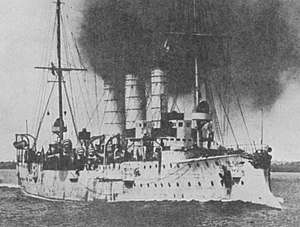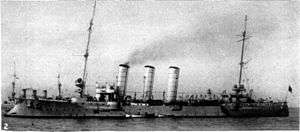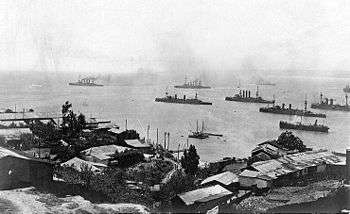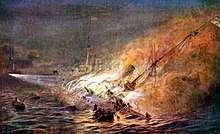SMS Leipzig (1905)
SMS Leipzig ("His Majesty's Ship Leipzig")[lower-alpha 1] was the sixth of seven Bremen-class cruisers of the Imperial German Navy, named after the city of Leipzig. She was begun by AG Weser in Bremen in 1904, launched in March 1905 and commissioned in April 1906. Armed with a main battery of ten 10.5 cm (4.1 in) guns and two 45 cm (18 in) torpedo tubes, Leipzig was capable of a top speed of 22.5 knots (41.7 km/h; 25.9 mph).
 | |
| History | |
|---|---|
| Name: | Leipzig |
| Namesake: | Leipzig |
| Builder: | AG Weser, Bremen |
| Laid down: | 1904 |
| Launched: | 21 March 1905 |
| Commissioned: | 20 April 1906 |
| Fate: | Sunk at the Battle of the Falkland Islands, 8 December 1914 |
| General characteristics | |
| Class and type: | Bremen-class light cruiser |
| Displacement: | |
| Length: | Length overall: 111.1 meters (365 ft) |
| Beam: | 13.3 m (43.6 ft) |
| Draft: | 5.61 m (18.4 ft) |
| Installed power: |
|
| Propulsion: |
|
| Speed: | 22 knots (41 km/h; 25 mph) |
| Range: | 4,690 nmi (8,690 km; 5,400 mi) at 12 kn (22 km/h; 14 mph) |
| Complement: |
|
| Armament: |
|
| Armor: |
|
Leipzig spent her career on overseas stations; at the outbreak of World War I in August 1914, she was cruising off the coast of Mexico. After rejoining with the East Asia Squadron, she proceeded to South American waters, where she participated in the Battle of Coronel, where the German squadron overpowered and sank a pair of British armored cruisers. A month later, she again saw action at the Battle of the Falkland Islands, which saw the destruction of the East Asia Squadron. Leipzig was chased down and sunk by the cruisers HMS Glasgow and HMS Kent; the majority of her crew was killed in the battle, with only 18 survivors.
Design
The German 1898 Naval Law called for the replacement of the fleet's older cruising vessels—steam corvettes, unprotected cruisers, and avisos—with modern light cruisers. The first tranche of vessels to fulfill this requirement, the Gazelle class, were designed to serve both as fleet scouts and as station ships in Germany's colonial empire. They provided the basis for subsequent designs, beginning with the Bremen class that was designed in 1901–1903. The principle improvements consisted of a larger hull that allowed for an additional pair of boilers and a higher top speed.[1]
Leipzig was 111.1 meters (365 ft) long overall and had a beam of 13.3 m (44 ft) and a draft of 5.61 m (18.4 ft) forward. She displaced 3,278 metric tons (3,226 long tons) as designed and up to 3,816 t (3,756 long tons) at full load. Her propulsion system consisted of two triple-expansion steam engines with steam provided by ten coal-fired Marine-type water-tube boilers. Her propulsion system was rated at 10,000 metric horsepower (9,900 ihp) for a top speed of 22 knots (41 km/h; 25 mph). Leipzig carried up to 860 t (850 long tons) of coal, which gave her a range of 4,690 nautical miles (8,690 km; 5,400 mi) at 12 knots (22 km/h; 14 mph). She had a crew of 14 officers and 274–287 enlisted men.[2]
The ship was armed with ten 10.5 cm (4.1 in) SK L/40 guns in single mounts. Two were placed side by side forward on the forecastle, six were located amidships, three on either side, and two were placed side by side aft. The guns could engage targets out to 12,200 m (13,300 yd). They were supplied with 1,500 rounds of ammunition, for 150 shells per gun. For defense against torpedo boats, she carried ten 3.7 cm (1.5 in) Maxim guns in individual mounts. She was also equipped with two 45 cm (17.7 in) torpedo tubes with five torpedoes. They were submerged in the hull on the broadside. She was also fitted to carry fifty naval mines. The ship was protected by an armored deck that was up to 80 mm (3.1 in) thick. The conning tower had 100 mm (3.9 in) thick sides, and the guns were protected by 50 mm (2 in) thick gun shields.[2][3]
Service history

Leipzig was ordered under the contract name "N"[lower-alpha 2] and was laid down at the AG Weser shipyard in Bremen in 1904 and launched on 21 March 1905, after which fitting-out work commenced. She was commissioned into the High Seas Fleet on 20 April 1906.[4] Franz von Hipper served as the ship's first commanding officer, from her commissioning in April until September,[5] when Leipzig was deployed overseas,[6] and was assigned to the East Asia Squadron, along with the armored cruisers Scharnhorst and Gneisenau and the light cruisers Emden and Nürnberg.[7]
The ship was cruising off the west coast of Mexico at the outbreak of World War I in August 1914 to show the flag in the Americas. In addition, Leipzig had been tasked with safeguarding German nationals in Mexico during a period of unrest. She spent the first weeks of the conflict patrolling for British-flagged merchantmen off San Francisco before stopping in the Galapagos Islands on 18 August, on her way to South America. A week later, Leipzig sank a British freighter carrying sugar and then proceeded to the Peruvian coast by the 28th. She stopped in Guaymas in neutral Mexico to take on a fresh load of coal on 8 September.[8][9]
On 14 October, she joined the rest of Vice Admiral Maximilian von Spee's East Asia Squadron at Easter Island; she brought with her three colliers. On 18 October, the Squadron departed, bound for South America; they stopped in the Juan Fernández Islands while en route, and by 26 October, they were approaching Mas a Fuera. They then steamed to Valparaiso, Chile, where they received intelligence that indicated that the British cruiser HMS Glasgow was anchored in Coronel. Von Spee decided to proceed to Coronel to ambush the British ship when it left port. Glasgow was in fact joined by the armored cruisers HMS Good Hope and HMS Monmouth.[10]
Battle of Coronel

While patrolling off Coronel, Leipzig stopped a Chilean barque and searched her, but since she was a neutral vessel, and not carrying contraband, the Germans let her go. At 16:00 on 1 November, Leipzig spotted a column of smoke in the distance, followed by a second ship at 16:17, and a third at 16:25. The British spotted Leipzig at approximately the same time, and the two squadrons formed into lines of battle. Leipzig was the third ship in the German line, behind the two armored cruisers. At 18:07, von Spee issued the order "Fire distribution from left", meaning that each ship would engage its opposite number; the Germans fired first, at 18:34.[11]
Scharnhorst and Gneisenau quickly wrecked their British counterparts, while Leipzig fired at Glasgow without success. At 18:49, Glasgow hit Leipzig, but the shell was a dud and did not explode. Leipzig and Dresden hit Glasgow five times before von Spee ordered Leipzig to close with the stricken Good Hope and torpedo it. A rain squall obscured the ship, and by the time Leipzig reached Good Hope's position, the latter had sunk. Unaware of the sinking of Good Hope, no rescue operations were mounted by Leipzig's crew. By 20:00, Leipzig encountered Dresden in the gathering darkness, and the two initially mistook each other for hostile warships, though they quickly established their identity. Leipzig emerged from the battle essentially unscathed, and with no wounded crewmen.[12]
In the aftermath of the Battle of Coronel, von Spee decided to return to Valparaiso to receive further orders; while Scharnhorst, Gneisenau, and Nürnberg went into the harbor, Leipzig and Dresden escorted the colliers to Mas a Fuera. The rest of the East Asia Squadron joined them there on 6 November; the cruisers restocked their coal and other supplies. On 10 November, Leipzig and Dresden were sent to Valparaiso, arriving on the 13th. Five days later, they rejoined the Squadron approximately 250 nautical miles (460 km; 290 mi) west of Robinson Crusoe Island; the unified Squadron then proceeded to the Gulf of Penas, arriving on 21 November. There, they coaled and prepared to make the long voyage around Cape Horn. The British, shocked by their defeat at Coronel, had meanwhile dispatched the powerful battlecruisers HMS Invincible and HMS Inflexible, under the command of Vice Admiral Doveton Sturdee, to hunt down and destroy von Spee's ships. They departed Britain on 11 November and reached the Falkland Islands on 7 December, having been joined on the way by the armored cruisers Carnarvon, Kent, and Cornwall and the light cruisers Bristol and the battered Glasgow.[13]
Battle of the Falkland Islands

On 26 November, the East Asia Squadron departed the Gulf of Penas, bound for Cape Horn and the Atlantic and reached the Cape on 2 December. While off the Cape, Leipzig took the Canadian sailing ship Drummuir as a prize; the ship was carrying 2,750 t (2,710 long tons; 3,030 short tons) of coal, which was transferred to the colliers Baden and Santa Isabel at Picton Island. On the night of 6 December, von Spee held a conference with the ship commanders to discuss his proposed attack on the Falklands; Fregattenkapitän Haun, the commander of Leipzig, along with the commanders from Gneisenau and Dresden, opposed the plan and favored bypassing the Falklands to wage commerce war off La Plata. Nevertheless, von Spee made the decision to attack the Falklands on the morning of 8 December.[14]
The Germans approached Port Stanley, the capital of the Falklands, early on the morning of 8 December; the British quickly spotted them, and raised steam to go out and meet them. Von Spee initially thought the smoke clouds to be the British burning their coal stocks to prevent the Germans from seizing them. Upon realizing the presence of the powerful British squadron, he broke off the attack and turned to flee. The British quickly steamed out of the harbor in pursuit. By 12:55, the battlecruisers had caught up to the retreating Germans, and opened fire on Leipzig, the last ship in the German line, though she was not hit. Von Spee ordered the light cruisers to detach and flee while Scharnhorst and Gneisenau turned on their pursuers, in the hope that he could cover their escape.[15] In response, Sturdee sent his cruisers to chase down Nürnberg, Dresden, and Leipzig.[16]
Glasgow pursued Leipzig, and quickly caught up, opening fire by 14:40. After about twenty minutes of firing, Leipzig was hit; she turned to port to open the range, before turning to starboard in order to bring her full broadside into action. In the ensuing action, both ships were hit several times, forcing Glasgow to break off and fall behind the more powerful armored cruisers. Leipzig was battered severely by Cornwall and Kent and set on fire; she nevertheless remained in action and continued to fight. In the course of the engagement, Leipzig hit Cornwall eighteen times, causing a significant list to port. She fired three torpedoes at the British ships, but failed to score any hits with them. At 19:20, Haun issued the order to scuttle his wrecked ship; the British approached and opened fire on the stricken cruiser at close range, killing large numbers of the crew. The British also destroyed a cutter filled with survivors, killing all of them. Leipzig finally capsized and sank at 21:05, with Haun going down with his ship. Only eighteen men were pulled from the freezing water.[17]
Notes
Footnotes
- "SMS" stands for "Seiner Majestät Schiff" (German: His Majesty's Ship).
- German warships were ordered under provisional names. For new additions to the fleet, they were given a single letter; for those ships intended to replace older or lost vessels, they were ordered as "Ersatz (name of the ship to be replaced)".
Citations
- Hildebrand, Röhr, & Steinmetz Vol. 2, p. 124.
- Gröner, pp. 102–103.
- Hildebrand, Röhr, & Steinmetz Vol. 5, p. 211.
- Gröner, pp. 102–104.
- Philbin, p. 7
- Gröner, p. 104.
- Staff, p. 28.
- Marley, p. 634
- Staff, pp. 29–30.
- Staff, pp. 30–31.
- Staff, pp. 31–33.
- Staff, pp. 34–37, 39.
- Staff, pp. 58–60.
- Staff, pp. 61–62.
- Staff, pp. 62–66.
- Halpern, p. 99.
- Staff, pp. 73–76.
References
- Gröner, Erich (1990). German Warships: 1815–1945. Vol. I: Major Surface Vessels. Annapolis: Naval Institute Press. ISBN 978-0-87021-790-6.
- Halpern, Paul G. (1991). A Naval History of World War I. Annapolis: Naval Institute Press. ISBN 978-1557503527.
- Hildebrand, Hans H.; Röhr, Albert & Steinmetz, Hans-Otto (1993). Die Deutschen Kriegsschiffe: Biographien: ein Spiegel der Marinegeschichte von 1815 bis zur Gegenwart (Band 2) [The German Warships: Biographies: A Reflection of Naval History from 1815 to the Present (Vol. 2)] (in German). Ratingen: Mundus Verlag. ISBN 978-3-8364-9743-5.
- Hildebrand, Hans H.; Röhr, Albert & Steinmetz, Hans-Otto (1993). Die Deutschen Kriegsschiffe: Biographien: ein Spiegel der Marinegeschichte von 1815 bis zur Gegenwart (Band 5) [The German Warships: Biographies: A Reflection of Naval History from 1815 to the Present (Vol. 5)] (in German). Ratingen: Mundus Verlag. ISBN 978-3-7822-0456-9.
- Marley, David F. (1998). Wars of the Americas. Santa Barbara: ABC-CLIO. ISBN 0-87436-837-5.
- Philbin, Tobias R., III (1982). Admiral von Hipper: The Inconvenient Hero. Amsterdam: B. R. Grüner Publishing Co. ISBN 90-6032-200-2.
- Staff, Gary (2011). Battle on the Seven Seas. Barnsley: Pen & Sword Maritime. ISBN 978-1-84884-182-6.